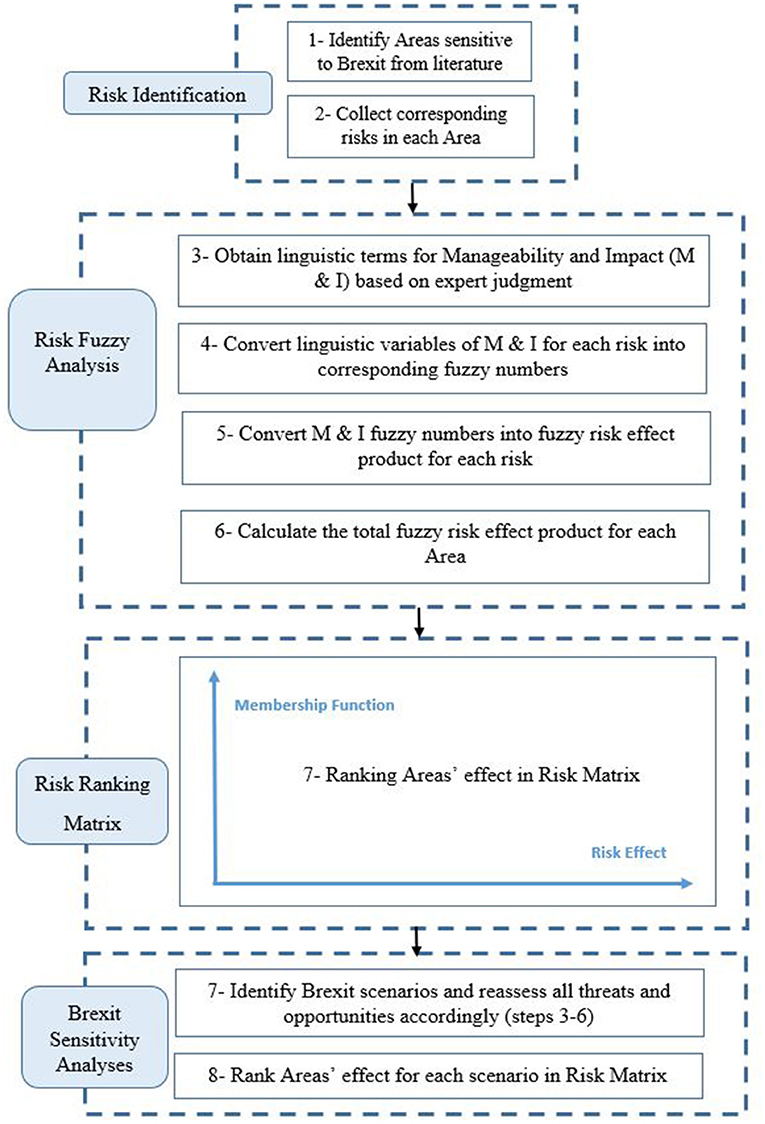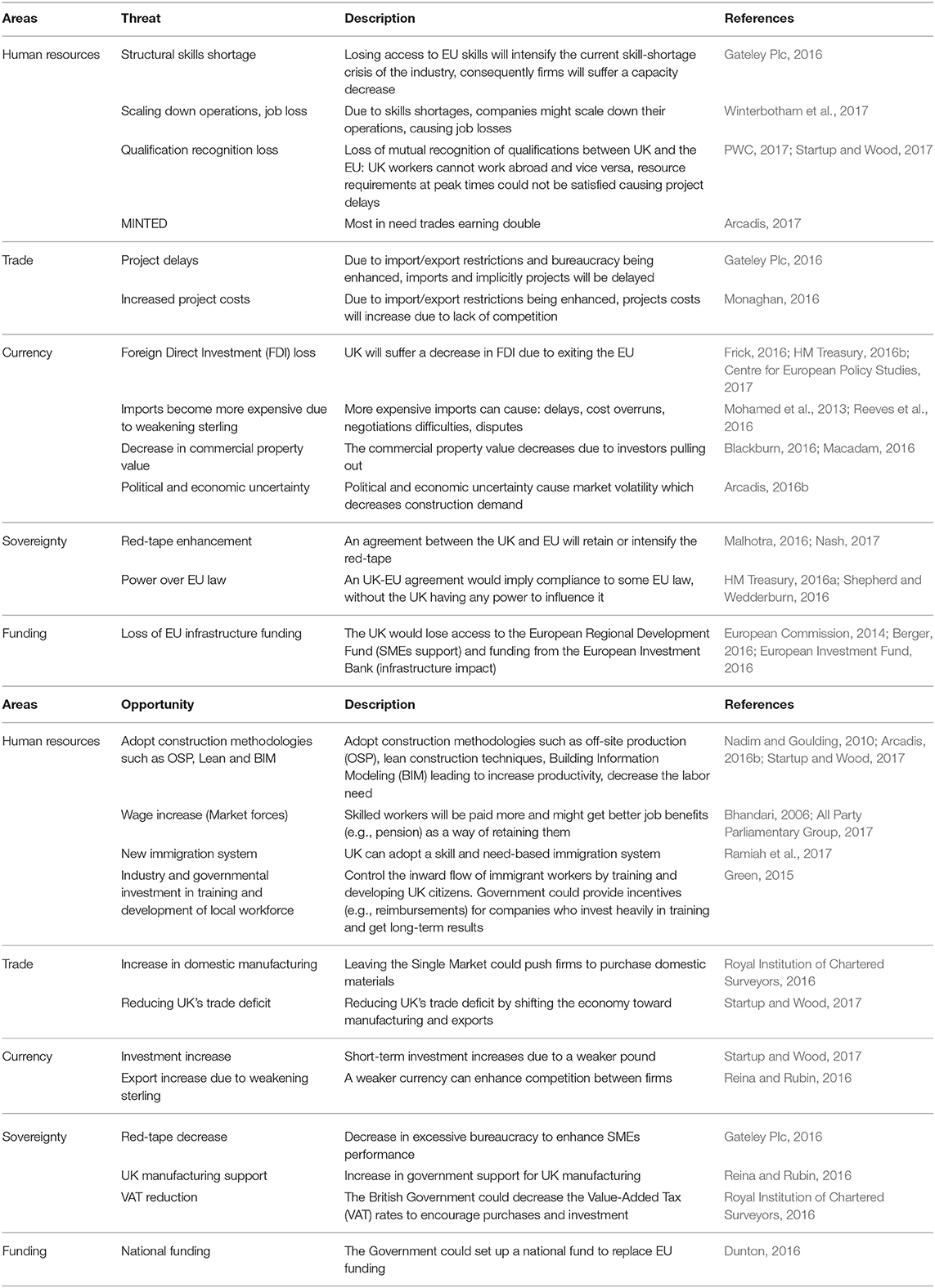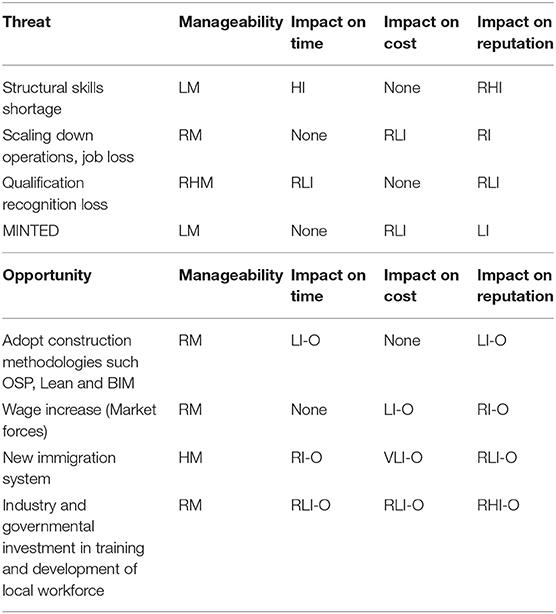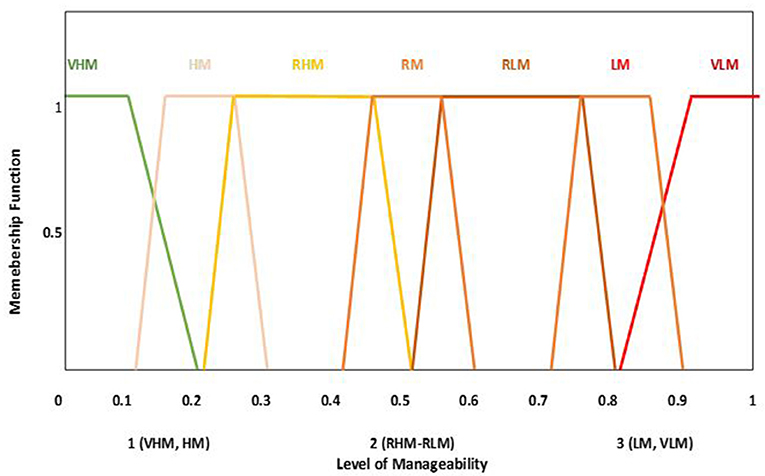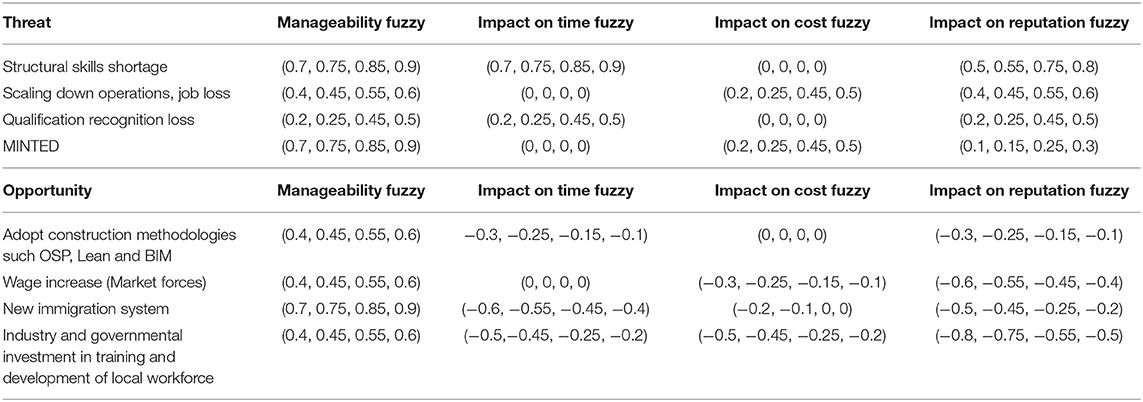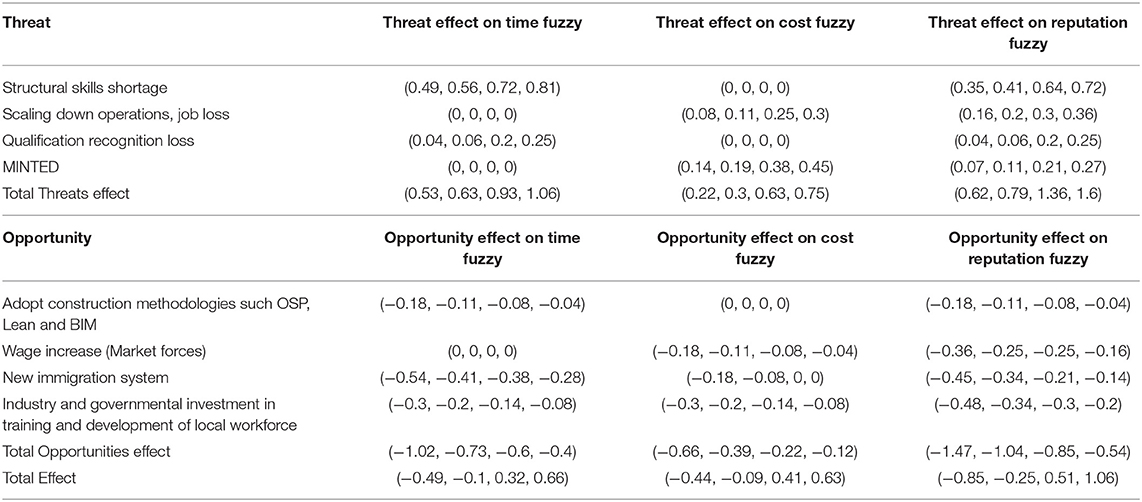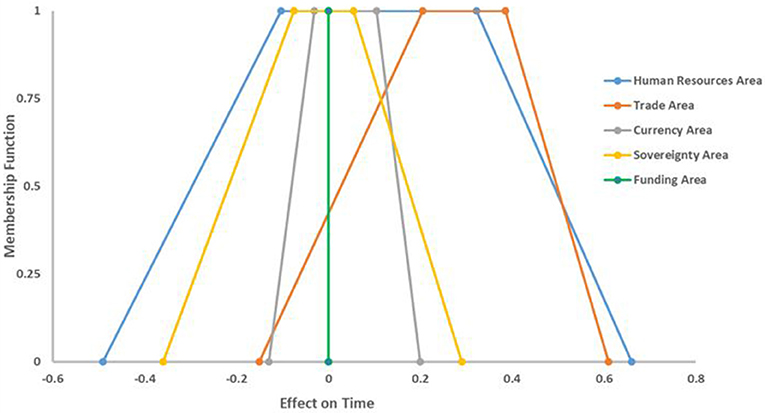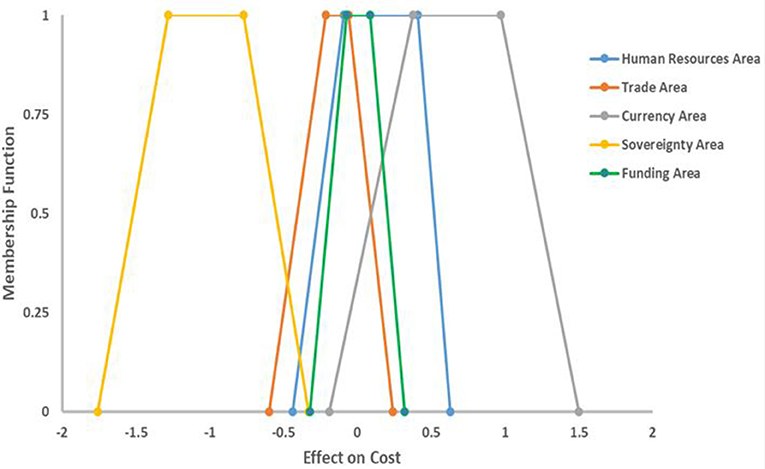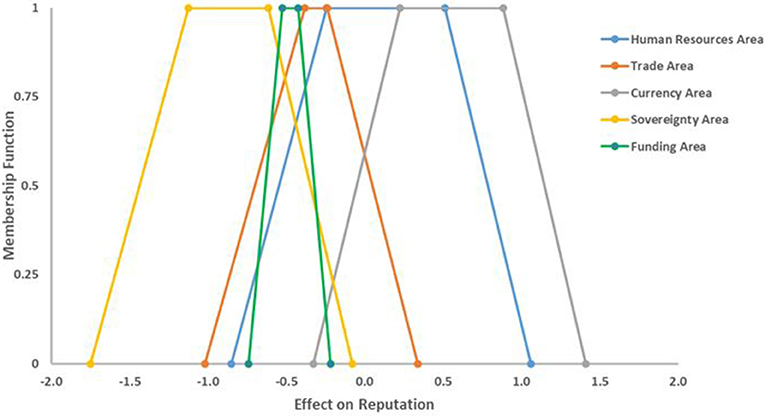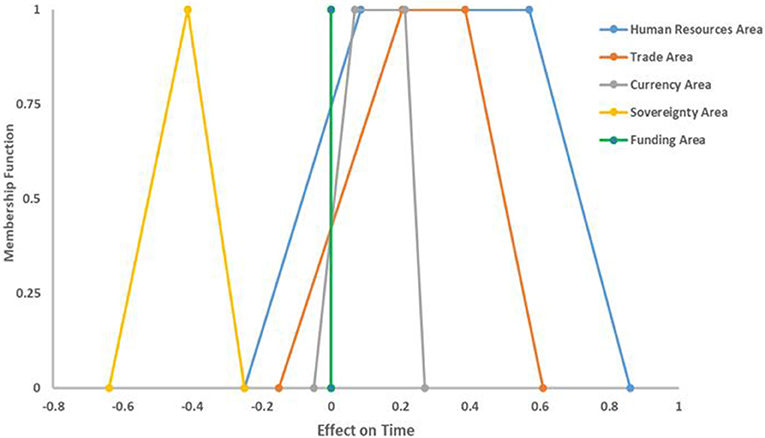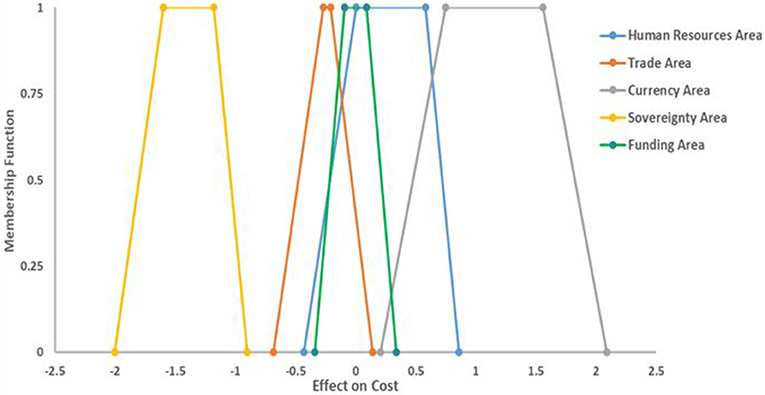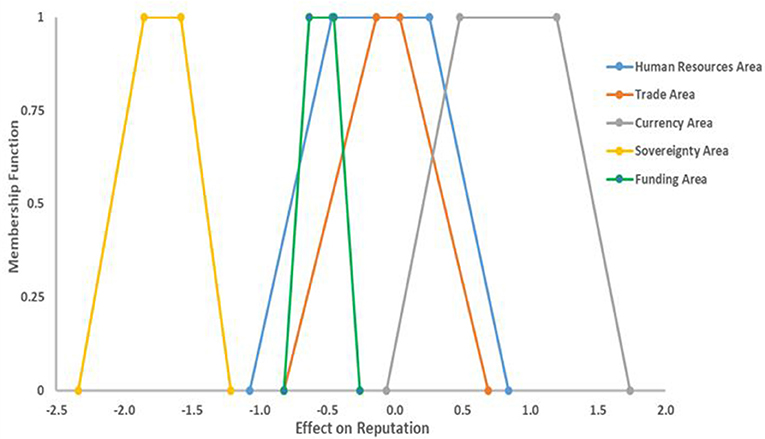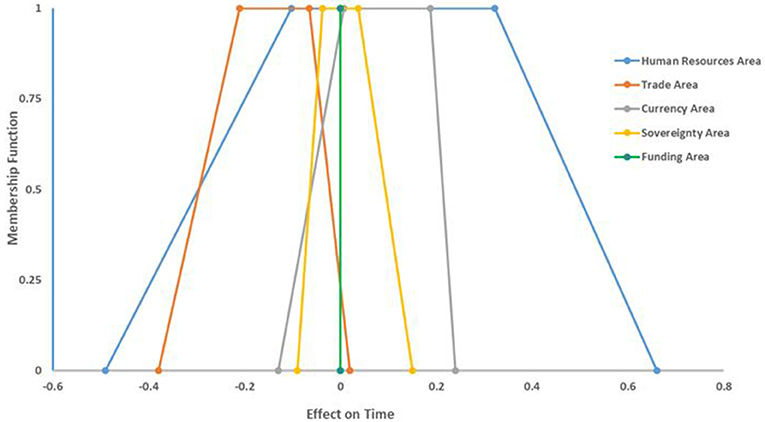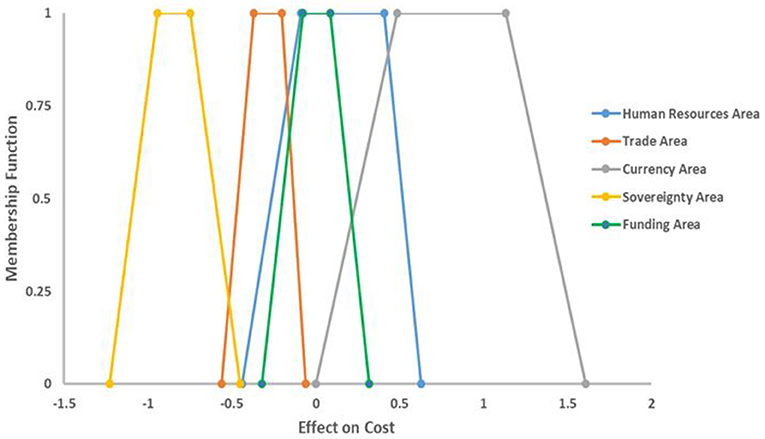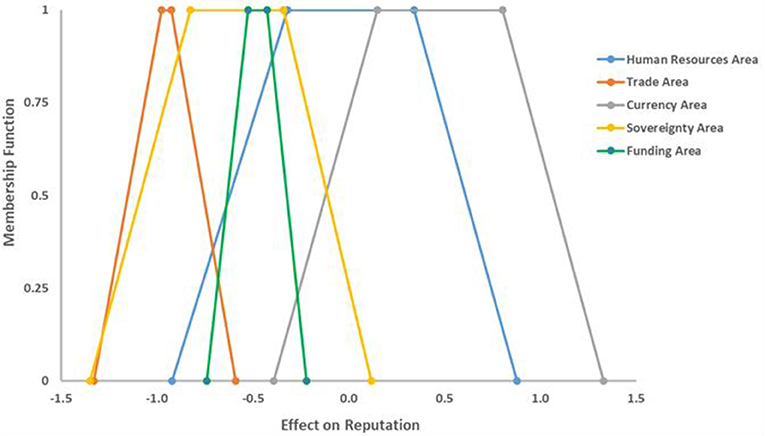Analyzing the Effect of Brexit on the British Construction Industry Using Fuzzy Sets Theory
- 1Department of Civil Engineering, University of Birmingham, Birmingham, United Kingdom
- 2Independent Researcher, Birmingham, United Kingdom
- 3School of Civil Engineering, Tishreen University, Lattakia, Syria
Policymakers are continually facing new challenges that are exacerbated by the lack of dedicated analysis of how macroeconomic changes affect particular industries. One of the most current examples of this is the effect that Brexit will have on the British construction industry. This paper addresses the issue by deploying a new risk-based approach that utilizes the triangulation concept across risk impact, risk manageability, and the combination of those two factors. The novelty of this framework lies in the use of Fuzzy Theory to appraise the effect of a significant phenomenon when confronted with the absence of quantitative data. The research methodology adopts Fuzzy Sets Theory to assess the effect of Brexit upon the Human Resources, Currency, Trade, Funding, and Sovereignty areas of the industry to illustrate their vulnerability to time, cost, and reputation impacts. This novel approach overcomes biases by adopting Fuzzy set theory in assessing risks, and by focusing on the manageability of these risks in their external and internal environments, as opposed to the likelihood of risk occurrence. The research indicatively concluded that the areas most susceptible to Brexit are Human Resources and Currency, followed by Trade.
Introduction
2018 marks the 10th anniversary of the most significant economic turmoil since the Great Depression. According to the Royal Institute of International Affairs (2018), the process of responding to the 2008 crisis (and the changes to the governance of the eurozone financial system in particular) took almost a decade to implement before there were signs of reliable recovery across the US and Europe.
Labeled the “Eurosceptic State” for the past couple of decades (Balch and Balabanova, 2017), the United Kingdom decided in favor of withdrawing from the European Union in the intensely publicized June 2016 referendum (Besch and Black, 2016). Following the vote, Prime Minister David Cameron resigned, while Scotland publicly confirmed the possibility of the United Kingdom (UK) breaking up, since both Scotland and Northern Ireland voted to “Remain” (Shaw, 2017).
The European Union (EU) is a political and economic coalition of 28 European countries, with roots in organizations constructed during the 1950s to further the aim of using economic integration to promote peaceful relationships between continental states (Craig and De Búrca, 2011; Kroll and Leuffen, 2016). The most important project of the EU has been the establishment of the European Economic Area (EEA), or “Single Market,” which is founded on the “four freedoms” of goods, labor, capital, and services (Doherty, 2016).
The current literature provides studies (research papers, industry studies, governmental analyses) regarding the effect of Brexit upon various themes, such as: Britain's economy (Ebell and Warren, 2016; HM Treasury, 2016a; KPMG, 2017), free movement of people/immigration (Doherty, 2016; Portes, 2016), workers' rights (Ford, 2016), the rationale behind voting patterns (Hobolt, 2016; Matti and Zhou, 2017), trade (Dhingra et al., 2016) etc. By analyzing the stock price indices for the day following the referendum, Ramiah et al. (2017) concluded that the construction and materials sector had a below-average performance and was one of the sectors that immediately experienced increased threats.
Due to the complexity of Brexit, and despite the fact that the construction industry is very susceptible to its effect (PWC, 2016; Rhodes and Wilson, 2016; Cambridge Econometrics, 2018); only a few industry papers such as: Arcadis (2016a), Gateley Plc (2016), and Shepherd and Wedderburn (2016) have explored the event's potential consequences for it.
This paper establishes an integrated risk-based approach to address this issue, and provides decision makers with a suitable means of understanding the change wrought by such a significant phenomenon in a complex, time-dependent and dynamic environment.
The definition of “construction industry” in this paper includes: (i) architecture and engineering; (ii) building construction; (iii) civil engineering; (iv) specialized services (e.g., facade engineering); (v) materials and components; (vi) plant and equipment (Lowe, 2011). The analysis will assume both that the European Union remains stable, that the UK stays unified, that the global financial market remains sound, and that a negotiated settlement is reached regarding frictionless trade across the Irish border.
Research Methodology: Risk-Based Approach on Brexit
The choice of research methodology is informed by the approach that best addresses the research question (Bryman, 2016). Risk analysis is widely used in public policy to “objectively” inform decisions. However, there is a natural impediment associated with obtaining “accurate” risk values. This is driven by the fact that risk analysis, including the techniques used, entail subjectivity. With risk, there is uncertainty and need for judgement, and hence risk analysis retains considerable scope for inaccuracy and bias (Howarth, 2007; Koradecka et al., 2010; Boholm and Corvellec, 2011). Conducting a risk analysis to inform decisions associated with the outcomes of Brexit is no different, because the results obtained by pro-Brexit analysts are unlikely to be the same as those obtained by anti-Brexit analysts, despite both having access to the same information.
The problem is coupled to the lack of historic and forecast numerical data relating to the potential effect of Brexit. The research methodology will therefore use Fuzzy Sets Theory to qualitatively analyse the risk posed by Brexit to the construction industry in the UK.
Fuzzy Sets Theory has been widely used in addressing uncertainty in qualitative and quantitative risk analysis (Ross, 2010; Yang et al., 2011; Tongyuan et al., 2018). Due to its ability to accommodate the scarcity of numerical data, its ability to incorporate evolving data, and its comparative simplicity, the qualitative approach has been selected for this research (Coppola, 2010; Rausand, 2011). Qualitative research encompasses various distinct traditional methods (Panas and Pantouvakis, 2010), but as the researcher acts as the data collection instrument, this type of research is subject to extensive criticism regarding its rigor (Merriam, 2009).
To overcome these methodological pitfalls, this paper proposed a new risk-based framework that utilizes the triangulation concept. Triangulation refers to the use of either methods, investigator, theory, or data-source triangulation in qualitative research to embrace the quality and credibility of a qualitative analysis (Patton, 2001).
Data-source triangulation strategies were used to form the “experts' opinion,” using the criterion that an expert had successfully published their work in a peer-reviewed research paper, industry study and/or governmental analysis. The number of experts consulted was therefore guided by the ~200 critically-reviewed pieces of literature this paper used.
The method used in this paper involved reporting published expert views on Brexit's potential threats and opportunities, qualitatively assessing these risks, and then presenting their impact and level of manageability as fuzzy numbers. Because the available literature naturally adopts either a pro- or anti-Brexit stance, this paper categorized its data sources accordingly and assessed threats using the opinion of anti-Brexit commentators only. Similarly, opportunities were assessed by pro-Brexit commentators only, to ensure strong representation of relevant views. Finally, to overcome biases all assessments were maintained as fuzzy parameters. This approach was also adopted when assessing impacts against their level of manageability.
This novel framework triangulates the qualitative assessment of risk impact, risk manageability, and the combination of those two parameters. It also objectively separates risks into threats and opportunities to overcome potential overlaps in impact and manageability assessments. In order to develop an inclusive understanding of the uncertain effect of Brexit, this approach deploys fuzzy logic analysis to qualitatively represent these parameters as fuzzy numbers (Zadeh, 1975; Ross, 2010; Yang et al., 2011; Tongyuan et al., 2018).
The combined effect of the threats and opportunities is then presented in a fuzzy effect risk matrix as a plausible range of outcomes rather than as a single subjective view. Risk matrices have been in use since 1978 to determine the level of risk as a means of informing decision-making priorities (Peace, 2017). They have been widely used when the risk attributes are unknown or cannot be accurately measured (Cox and Huber, 2008).
The use of triangulation strategies in qualitative research is a well-established method of ensuring validity through the convergence of data/methods to understand a phenomena and its aftermath (Carter et al., 2014).
The research methodology, shown in Figure 1, detailed in the following subsections, will have the following steps:
1- Using existing literature, establish what areas of the construction business are most susceptible to Brexit. Then identify the threats and opportunities belonging to these areas;
2- Deploy fuzzy risk analysis to determine how substantial are the identified risks by assessing their impact and manageability;
3- Adapt a risk matrix to illustrate the fuzzy effect of Brexit across the identified areas of the construction industry;
4- Undertake sensitivity analyses using various Brexit scenarios to test the robustness of the results against changes in the risk assessment.
Risk Identification: Areas and Their Corresponding Risks
In the construction field, when the state of knowledge is inadequate, Fellows and Liu (2015) considered qualitative methods to be a suitable methodology for locating the research parameters and context, and of providing insights into previous work (Blaxter et al., 2001).
To overcome biases in the cross-section elements of the data sample, a triangulated sampling of published datasets over a prolonged period has been used as a collection method (Barbour, 2001; Creswell, 2007). This has been achieved by acknowledging the diverse views present in over 200 critically-reviewed research papers, industry studies and governmental reports. Accordingly, this paper identifies the following set of construction business areas as being the most vulnerable to the possible effects of Brexit:
• Human Resources: concerns relating to the construction industry workforce, from a lack of available skills to qualification and salary matters (Sweet and Smith, 2017);
• Trade: involves EU and international trade and how Brexit could alter barriers and impact UK trade flows (Royal Institution of Chartered Surveyors, 2016);
• Currency: refers to Sterling fluctuations and their implications for the market (Reeves et al., 2016);
• Sovereignty: considers the legislative and administrative aspect of the event and the UK's power to influence it (Shepherd and Wedderburn, 2016);
• Funding: concentrates on EU funding aimed at the industry (Berger, 2016).
The threats and opportunities identification is based on the area identification, as they represent the principal categories of risks posed by Brexit. The risk identification will focus on each area individually and will be accompanied by relevant literature, which will support the rating process undertaken in the risk analysis.
Human Resources
Two months prior to the referendum, the construction industry experienced a decrease in activity, and 56% of firms reported skills shortages (Blackburn, 2016). The proportion of EU nationals working in the UK construction industry was around 8% in 2017 (Rolfe and Hudson-Sharp, 2016; Royal Institution of Chartered Surveyors, 2017). However, the percentage is not uniform throughout the country, with EU nationals accounting for 27% of London's total figure (Greater London Authority, 2017). This becomes important to the British construction field when considering the skills crisis that has been a problem for the past couple of decades (Dainty et al., 2004).
The skills shortage originates mainly from an old workforce, a lack of appeal to youngsters (Sweet and Smith, 2017), high false self-employment (Behling and Harvey, 2015), and low levels of training (CIOB, 2015). Sweet and Smith (2017) highlighted that 68% of current employees in the construction sector are aged 45–56 years, and so are preparing to retire in the coming years. Moreover, the industry struggles to attract new entrants, especially women, due to its bad reputation of being a “dirty profession” (Department for Business Innovation and Skills, 2016). Major contractors win tenders and pass the work to subcontractors that inevitably carry the burden of labor training without being able to afford it. Consequently, 40% of the sector is self-employed and only 57% of companies offer training (Department for Business Innovation Skills, 2013). In 2015, the number of first-year trainees in the entire industry was 14,900, in comparison to 45,000 trainees in 2005 (Sweet and Smith, 2017).
In the past 2 years the government has announced a series of infrastructure projects worth over £500 billion (including HS2, Hinkley Point C, Thames Tideway Tunnel) (All Party Parliamentary Group, 2017), while the housing sector needs to construct around 110,000 houses each year to meet the projected demand. This will require more than 400,000 employees each year to keep up with current infrastructure and housing necessities. In other words, the industry must recruit one person every 77 s, omitting any potential impact of Brexit (Arcadis, 2017).
Shepherd and Wedderburn (2016) argued that EU nationals will choose other EU countries to work in, as the UK would become a less welcoming place due to difficult visa applications and a Sterling Pound with lower value. Balfour Beatty made clear that in 2016, it only recruited 0.2% of employees from non-EU countries because the points-based sponsor license system imposes high costs and administrative complexity, and is too time consuming (Sweet and Smith, 2017). Nevertheless, Brexit could act as an incentive for the government to establish a new needs-based immigration system designed to fill all skills deficiencies in the industry (Ramiah et al., 2017).
Key industry players, such as Rogers Stirk Harbor and Partners, Barratt Developments and Crossrail, have declared that 40% of their professionals are non-British EU citizens (Mellors-Bourne et al., 2017), and that leaving the EU will therefore pose a real problem for their operations. Similarly, the Royal Institute of British Architects (RIBA) stressed that 25% of the UK's registered architects come from the EU (All Party Parliamentary Group, 2017), while Canary Wharf Group announced that a couple of buildings in the Canary Wharf project will be slowed down as a measure of protection against the effects of Brexit (Brexit Slows Wharf Construction, 2016). EU labor is also essential for small businesses, because of their substantial need of less skilled tradesmen such as bricklayers and carpenters (Farah, 2016). Reports showed that skill shortages caused an increase of around 6% in average wages in 2015 (Shepherd and Wedderburn, 2016).
On a positive note, certain opportunities such as Off-site Production (OSP), equipment investment, and lean construction techniques could counterbalance these threats by increasing productivity and lessening the labor need (Nadim and Goulding, 2010; Arcadis, 2016a,b). A growth in work productivity could decrease, to a certain extent, the number of personnel required (Mackenzie et al., 2000). Both lean techniques and Building Information Modeling (BIM) could increase efficiency, reducing the labor need and lessening the skill-shortage pressure. They are known to reduce waste in terms of materials, resources and cost (Eadie et al., 2013), to increase productivity and quality (Mossman, 2009; Poirier et al., 2015), and to decrease costs and completion times (Mossman, 2009).
Furthermore, Brexit is expected to diminish housing demand by reducing the number of immigrants coming into the UK, consequently attenuating the skill-shortage issue (Dunton, 2016). This, however, is expected to lower domestic demand levels (Berger, 2016). Despite having one of the highest fertility rates in Europe (McDonald and Moyle, 2010; Eurostat, 2017), the UK has since 1990 experienced an increased number of births by women not born in the UK, reaching 28.2% in 2016 (ONS, 2017a). Notwithstanding this, the UK's population is estimated to grow despite lower immigration levels in the next 10 years (ONS, 2017b). The complete identification outcome for this area has been compiled in Table 1, along with the corresponding literary references.
Trade
The European Union contains the European Economic Area (Single Market), of which the Customs Union is a key pillar. The Customs Union guarantees tariff-free trade between all members and dictates a common external tariff with outside states, forbidding members from signing bilateral trade agreements with non-EU countries (Malhotra, 2016). A state can be in the Customs Union (e.g., Turkey) or the EEA (e.g., Norway) without being an EU member (Bloom, 2017).
The Leave side underlined that leaving the EU would allow the UK to be independent and to trade as it pleased with the entire world (Marshall, 2016). However, this implies renegotiating new agreements with over 50 countries outside the EU, commencing negotiations with 67 other nations (HM Treasury, 2016b), setting customs regulations between Northern Ireland and Ireland, and increased difficulties when exporting from the UK to the EU (Malhotra, 2016). Besides the time-consuming nature of the exit negotiation, the UK lacks sufficient negotiators to construct international trade agreements quickly (Ghemawat, 2017) and has a Gross Domestic Product roughly a fifth of the remaining EU (HM Treasury, 2016b), weakening its bargaining position in the world. Although Liam Fox, the UK Trade Secretary, has visited 55 countries as of January 2017, the UK is discussing potential agreements with only 12 (Trommer, 2017).
Negotiations for an EU-USA agreement are currently underway (Mugarura, 2016), which would directly benefit the UK because the USA is its largest non-EU trade partner (HM Treasury, 2016b). Michael Froman, the US Trade Representative until 2017, suggested that the EU is a bigger economic power, and implicitly has more influence regarding world trade, than the UK would be on its own (Mugarura, 2016). Likewise, the Commonwealth governments advised Britain to retain EU membership (Marshall, 2016).
Studies have shown that being a member of the EU has reduced trading costs for the UK (HM Treasury, 2016b) and, without considering the effects of Brexit, the British building materials market is set to grow in value between 2015 and 2020 (Market Line, 2016). Even though it sources key materials domestically, the British construction industry imports some resources from the EU, which in 2014 accounted for 62% of the total figure (Department for Business Innovation and Skills, 2016). The construction industry by nature does not export, and only a very small percentage of British companies are involved in European projects (Berger, 2016). Accordingly, exports refer to the manufacture of construction products. Exports to the EU accounted for 59% of the total, with more than half of the UK's steel going to the EU (HM Treasury, 2016b). However, the most recent figures show that the UK has a trade deficit with the EU by importing twice as much as it exports (Department for Business Innovation and Skills, 2016). Although it is the 4th largest steel exporter in the world, British electricity prices are 1.5–2 times higher than those in France or Germany, making it difficult for the UK to be competitive. Should the currency weaken, import costs would increase and UK steel-makers may experience a demand boost at both national and international levels (Price, 2017).
Over time, British companies such as Tarmac, Blue Circle or Rugby Cement have been acquired by foreigners Lafarge and Cemex (Market Line, 2016), respectively. Brexit offers the UK the opportunity to decrease its trade deficit by supporting domestic manufacturing and exports (Startup and Wood, 2017). Although the top three products imported (electric wires, sawn wood, lamps, and fittings) do not involve basic construction materials, potential tariffs on imports could increase the cost of some production processes (Royal Institution of Chartered Surveyors, 2016). Peter Rogers, the co-founder of Lipton Rogers Developments, agreed that leaving the EU would affect the British construction industry due to its heavy reliance upon the EU for labor, materials, and trade in the Common Market (Farah, 2016).
All things considered, Brexit supporters are confident that the United Kingdom will secure a bespoke agreement with the European Union, for the sole reason that European economies, especially Belgium, Ireland, and the Netherlands (Centre for European Policy Studies, 2017), will want to avoid losing the EU's largest export market. However, the EU could provide harsh conditions of withdrawal to prevent a precedent being set (Besch and Black, 2016). The complete identification outcome for this area has been compiled in Table 1, along with the corresponding literary references.
Currency
The immediate effects of the referendum have been the loss of the UK's AAA credit rating, altered exchange rates and consequently inflation, plus the possibility of an as-yet-undetermined “divorce bill” for leaving the EU (Watts, 2017). In light of these changes, Aviva Investors and M and G Investments suspended their trading operations due to investors pulling out of the commercial property market. Large companies in the housebuilding sector like Barratt Developments, Redrow and Taylor Wimpey suffered falls in their share prices too (Macadam, 2016). Currency exchange fluctuations can affect the market share and stock price of a company, disturbing its competitive advantage (Kolhatkar and Dutta, 2013).
The 2016 devaluation of Sterling caused the biggest materials cost inflation since 2011 (Reina and Rubin, 2016). Yet, the following month, the Pound rose higher than the Euro after David Davis, UK Brexit secretary, admitted the possibility of the UK paying for access to the Single Market (Cunningham, 2016). The construction purchasing managers' indices (PMIs), which indicate the economic health of the construction sector (Kollewe, 2011), had decreased under the acceptable limit (50) prior to the referendum (HM Treasury, 2016a), proving that the uncertainty surrounding Brexit had caused a contraction of the sector. However, the sector recovered in early 2017 and is currently experiencing slow growth in activity, indicating that Brexit-related uncertainty is deferring demand (Markit/CIPS, 2018).
Depreciation of the British Pound causes price increases in imports which can force companies to raise their prices to avoid lower profit margins (Mohamed et al., 2013; Reeves et al., 2016). This presents the risk of commercial impact for companies like Saint Gobain (Farah, 2016). Although a cheaper pound improves the competitiveness of exports, it does not automatically guarantee economic growth because exporters can choose to increase their prices in order to increase their profits, so the volumes exported do not change (PWC, 2017). Alternatively, exporters can choose to sell more at the depreciated price (Reeves et al., 2016). On the other hand, a weaker currency could improve competitiveness between British firms (Reina and Rubin, 2016).
Political uncertainty can also greatly discourage investment (Frick, 2016; HM Treasury, 2016b; Centre for European Policy Studies, 2017). In 2015, the UK was the 3rd most successful country in the world regarding inflows of foreign direct investments (FDI), which generally contributed to British infrastructure (UK Trade and Investment, 2018). Unfortunately, no literature could provide the exact share of EU FDI attributable to the construction industry. A study by the London School of Economics revealed that an EU exit would lower total FDI inflows by 2.2% (HM Treasury, 2016b). On the other hand, Britain offers advantages like language, light regulation and stable capital markets, so Brexit may not necessarily decrease FDI (Royal Institution of Chartered Surveyors, 2016).
Deloitte, Bank of England and the Confederation of British Industry have attested that investment has been diminishing both before and after the referendum, especially in the private commercial and industrial sectors (Blackburn, 2016; Macadam, 2016). London is the champion of commercial property investment in Europe, but in light of recent events, 66% of real estate professionals answering a KPMG survey believed that Brexit will lessen investment rates (Mugarura, 2016). However, it has also been argued that the fall in Sterling following the referendum was helping to preserve business investment in the short-term (because it makes investing in Sterling cheaper for foreign firms), but that this effect would wear off over time (Startup and Wood, 2017).
Political uncertainty can decrease demand, especially in areas such as commercial, premium residential, industrial developments, and repair and maintenance (Arcadis, 2016b). Miguel Jurado, chairman at FCC Construcción S.A., stated that although the referendum provoked a decline in demand, the government's support for major infrastructure projects helped to counteract this effect (Reina and Rubin, 2016). The identification outcome for this area has been compiled in Table 1, along with the corresponding literary references.
Sovereignty
Small and medium-sized enterprises (SMEs) in the UK have raised concerns regarding unjustified EU regulatory burdens (“red-tape”) (Doherty, 2016) that minimize their success on the market by favoring firms with previous experience on similar projects (Shepherd and Wedderburn, 2016). Although the UK's construction industry is mainly regulated by EU law (Guimarães, 2010), Scottish procurement regulations for example exceed EU requirements, so an exit will not necessarily produce a substantial change (Shepherd and Wedderburn, 2016).
European directives mainly govern procurement, environment (European Urban Waste Water Treatment Directive, Waste Framework Directive) and health and safety law (CDM Regulations, 2007), but they are deeply embedded into national legislation (CMS Cameron McKenna LLP, 2016). To be changed, these regulations must be repealed and replaced by new British legislation (Shepherd and Wedderburn, 2016). There is a high likelihood of retaining many EU regulations due to similarities with domestic law, or due to the beneficial changes they have brought (CMS Cameron McKenna LLP, 2016; Malhotra, 2016). The EU Timber Regulation (EUTR), even though it was not fully welcomed initially, has become an example of a positive EU regulation that has gained appreciation in the past 5 years and it is now considered to be a necessary measure for the industry (Environment European Commission, 2018).
Alternatively, the UK could adjust its national law and reduce the red-tape burden (Gateley Plc, 2016). These alterations could include specific provisions to support the manufacturing and construction sector, such as stipulating the preference for using British firms (Reina and Rubin, 2016), a practice which is currently banned by the EU (Gateley Plc, 2016; Royal Institution of Chartered Surveyors, 2016). This poses the risk of reducing effective competition in the market (CMS Cameron McKenna LLP, 2016). However, Łazowski (2016) argued that if the UK opts for an exit, it would have to identify all EU regulations and their domestic supporting acts, and keep, repeal or replace them with national provisions, while carrying the costs of this onerous exercise. Nevertheless, the UK would require a battalion of administrators and law specialists.
The EU positively affected the unregulated tendering procedures in the UK by providing a framework that prevents corruption and bribery (Royal Institution of Chartered Surveyors, 2016). Also, the EU introduced the value-added tax (VAT), which contributes heavily to the UK's finances (Daly, 2016). Importantly, however, Royal Institution of Chartered Surveyors (2016) stated that a decrease to 5% VAT for the construction industry would have created 95,000 jobs and provided a benefit of £15.1bn to the UK economy between 2015 and 2020.
In case an agreement is reached, the UK might be forced to accept enhanced regulations in exchange for benefits such as Single Market access, and it may also have to comply with regulations which it cannot influence after its membership expires (Malhotra, 2016). The EU Construction Products Regulation 305/2011 governs the trade of construction products within the EU. Whilst the regulation will cease to apply to the UK after the withdrawal, all products exported to the EU must comply with the regulation, meaning that the UK will need to follow laws which it cannot negotiate or influence (HM Treasury, 2016a; Shepherd and Wedderburn, 2016). Moreover, if the UK leaves the Single Market and Customs Union, imports and exports of goods and services will require more paperwork (Hunt and Wheeler, 2018). The complete identification outcome for this area has been compiled in Table 1, along with the corresponding literary references.
Funding
The European Investment Bank and the European Investment Fund are among the principal sources of funds for the UK's infrastructure and SMEs, backing 25% of infrastructure projects (i.e., circa €29bn) in the last 5 years (Berger, 2016) and creating many apprenticeships in the industry (European Investment Fund, 2016). Additionally, the EU also has the power to attract investment from other sources (Brexit Infrastructure Group, 2017). Although the UK could lose this funding, it continues to be attractive to international capital such as Saudi- and Dubai-based funds (Royal Institution of Chartered Surveyors, 2016). In addition, the UK could use the financial savings of not being an EU member to set up a national development fund to replace the European funds (Dunton, 2016). At the opposite pole, Watts (2017) declares that the UK has a hole in its budget that will make it challenging for the government to replace the funding provided by the EU. Furthermore, the UK may have to pay the EU an exit fee lately estimated to be around £38bn (Full Fact Organisation, 2019) or £91-£113bn by some other estimates (Roberts, 2017).
In addition, Brexit poses the risk of losing EU funding aimed at universities and research laboratories (Dunton, 2016). Britain is world-renowned for its prestigious higher education system which attracts a high number of EU researchers every year (Galbraith, 2017). One of the threats posed by Brexit is the termination of relationships with European universities. This is especially important since the UK shows signs of reluctance to increase the number of visas granted to international students.
In 2016, Theresa May visited India in an attempt to increase trade. When the host Prime Minister demanded relaxed visa conditions for Indian students in the UK, May subtly rejected the proposal and emphasized the efficiency of the current immigration system (Ghemawat, 2017). This position might bring a loss in diplomatic links for Britain, as international and European students are compelled to study elsewhere (Watts, 2017). The identification outcome for this area has been compiled in Table 1, along with the corresponding literary references.
Fuzzy Risk Analysis
In 1965, L.A. Zadeh published an article discussing fuzzy sets, and proposed the “fuzzy sets theory” to deal with uncertainties that are not random in nature. The basic idea is to replace the binary notion of “belonging” and “not belonging” to a given membership with a degree of belonging to it, and describing the transition between fuzzy information (Zadeh, 1975). The membership function μA(x1) specifies the degree to which any element x1 in the set A1 = {x1, x2, x3, x4, x5} belongs to the fuzzy set A, shown in Equation (1).
Fuzzy set theory has been used in several studies to aggregate the differences and subjectivity among expert opinions to overcome possible ambiguities (Zadeh, 1975; Ross, 2010; Yang et al., 2011; Tongyuan et al., 2018).
In accordance with the research methodology, and owing to the lack of numerical data supporting the previously identified risks, the linguistic variables of risk manageability and impact are firstly obtained and then described by fuzzy numbers (Zadeh, 1975; Ross, 2010; Yang et al., 2011; Tongyuan et al., 2018). The fuzzy level of manageability and impact of each risk is then informed by the significance afforded to their manageability and impact in existing literature from different fields.
The focus on the manageability of risks within their external and internal environments is a sound means of ensuring control and resilience when predicting the future (Taleb, 2008). Keizera et al. (2002) stated that it is not the likelihood and impact that are the best measures to determine the magnitude of risk, but rather the firm's ability to influence risk factors. The impact of risks is calculated by considering the intensity of potential cost and programme changes, and the reputational damage/influence incurred if the risk were to materialize (Aven and Vinnem, 2007).
Obtaining Linguistic Terms for Risk Manageability and Impact (M and I) Based on Expert Judgment
The purpose of this step is to determine the manageability and impact level of a risk considering the linguistic terms expressed by the experts in the literature. Risk industry standards and experts were consulted to determine how many levels of language were needed to describe these linguistic variables (Hillson and Simon, 2007; Cox, 2008; ISO 31000, 2009; Ball and Watt, 2013). To allow comparison and minimize bias in the assessment, this research uses seven levels to reflect uncertainty in expert opinion. This is accomplished by presenting the term “Low” as the range containing “very low,” “low,” and “relatively low”; whilst the term “High” is reflected in the range containing “relatively high,” “high,” and “very high.” “Medium” is presented as one level, because its upper and lower limits are covered by the “relatively low” and “relatively high” levels, respectively.
This description is based on Saaty's approach (Saaty and Ozdemir, 2003), who contended that the common capacity of human judgment is seven plus/minus two lots.
Accordingly, the linguistic terms, representing the manageability level, were scaled as: “very low manageability” (VLM), “low manageability” (LM), “relative low manageability” (RLM), “reasonable manageability” (RM), “reasonably high manageability” (RHM), “high manageability” (HM), and “very high manageability” (VHM).
The same was applicable for impact, where its fuzziness is described by “very low impact” (VLI), “low impact” (LI), “relative low impact” (RLI), “reasonable impact” (RI), “reasonably high impact” (RHI), “high impact” (HI), and “very high impact” (VHI).
As expert opinion is subject to bias, the research method balanced its inputs by considering the views of anti-Brexit commentators only in relation to the negative impact (threats) Brexit might have on the construction industry. The same logic was applied to pro-Brexit commentators in relation to the positive impact (opportunities) Brexit could have.
Take, for example, the Human Resources Area; at the risk identification stage, Gateley Plc (2016) argued that the existing skills-shortage crisis will worsen post-Brexit. This threat will have a high impact on the industry, as projects will suffer delays and damaged stakeholder confidence in delivery to time and budget. This threat will then have a high impact on time and relatively high impact on reputation, as the latter is a secondary impact to the former, as shown in Table 2.
Separately, the assessment method looked at the manageability Britain will have over these risks from the perspective of the same experts, as reported in ~200 pieces of critically-reviewed literature. Looking at the same threat of a structural skills shortage caused by Brexit, the level of manageability is low as there is an already existing shortage which will be intensified by restricting freedom of movement (Gateley Plc, 2016). Because some literature like Ramiah et al. (2017) argues that this shortage will be overcome by a new immigration system, this method treats potential changes to mitigate the effect of Brexit as opportunities. Hence, this opportunity is assessed with a high level of manageability as it is within the UK's power to put such a system in place, as shown in Table 2.
Table 2 presents the impact and manageability level of each threat and opportunity for the Human Resources Area using the linguistic terms expressed by experts.
Converting Linguistic Variables of M and I for Each Risk Into Corresponding Fuzzy Numbers
Yang et al. (2011), recommended the use of fuzzy reasoning as a function based on the fuzzy numbers for the transition of linguistic variables to mathematical language. There are many applications of fuzzy set theory to deal with uncertainties and inaccuracy in expert judgments in linguistic terms such as: triangular and trapezoidal fuzzy membership functions amongst others (Zadeh, 1975; Ross, 2010; Yang et al., 2011; Ferdous et al., 2013; Lavasani et al., 2015). This paper will use trapezoidal fuzzy number to define the mapping relation between experts' linguistic variables and the fuzzy function. This is in line with previous risk assessment studies (Zheng et al., 2012; Ramzali et al., 2015; Tongyuan et al., 2018).
The trapezoidal fuzzy number is presented as a quadruple (a, b, c, d) where aandd are the lower and upper bounds, and b andc are the lower and upper modal values, as shown in Equation (2)
Equation (3) below presents the manageability trapezoidal fuzzy number for threats
Equation (4) shows the corresponding functions for threat manageability levels as a trapezoidal fuzzy number (see Figure 2: Fuzzy Trapezoidal Number for the Level of Manageability for Threats).
This rating process for manageability is defined by considering which party can influence the risk. Risks that can be fully influenced by Britain are classified as belonging to the internal environment with a very/high manageability level. Conversely, those risks that cannot be influenced by Britain are defined as part of the external environment, with a very/low level of manageability. Additionally, when Britain can influence a risk within its risk appetite/tolerance, this is deemed to be a case of reasonably low/high manageability. Take again the risk of a structural skills shortage arising from the loss of EU skills, which has a low level of manageability (LM). LM is the sixth level of Equation (4), which means the manageability of this threat is presented by the trapezoidal fuzzy number (0.7, 0.75, 0.85, 0.9), as shown in Table 3. Values that are lower than 0.7 or higher than 0.9 have no membership of this function, while values in the range 0.7–0.75 and 0.85–0.9 possess a varying degree of membership. Values between 0.75 and 0.85 possess full membership of the LM fuzzy-set (see Equation 2).
By assigning membership across multiple ranges (Equation 4), analysts can counteract subjectivity when assessing uncertain events as fuzzy trapezoidal numbers.
Notably, LM as a trapezoidal fuzzy-set intersects with both “very low manageability” (VLM), and “relative low manageability” (RLM) fuzzy-sets, as shown in Equation (4). As a result, the conversion of the manageability level into a corresponding fuzzy number (as a set) carries a very low margin of bias.
Equation (5) below presents the impact trapezoidal fuzzy number for threats.
Equation (6) shows the corresponding functions for threat impact level as a trapezoidal fuzzy number. This is where the threat impact considers the intensity of cost increases, programme changes, and reputational damage incurred due to that particular threat. Take the same example around the structural skills shortage arising from the loss of access to EU skills, which has a reasonably high reputational impact (RHI) (Gateley Plc, 2016). RHI is the fifth level of Equation (6), which means the reputational impact of this threat is presented by the trapezoidal fuzzy number (0.5, 0.55, 0.75, 0.8), as shown in Table 3. Values lower than 0.5 or higher than 0.8 have no membership of this function, while values in the range 0.5–0.55 and 0.75–0.8 possess a varying degree of membership. Values between 0.55 and 0.75 possess full membership of the RHI fuzzy-set (see Equation 2).
As a trapezoidal fuzzy number, the RHI set intersects with both “reasonable impact” (RI) and “high impact” (HI) fuzzy-set numbers (see Equation 6). Accordingly, using this research methodology, the conversion of the impact level into corresponding fuzzy number carries a very low level of error.
Equation (7) below presents the impact trapezoidal fuzzy number for opportunities.
To ensure that the equal weighting of threats as well as opportunities is represented, the linguistic variables of risk impact for opportunities are presented by negative fuzzy numbers, as opportunities potentially reduce cost, time, and reputational damage.
Equation (8) shows the corresponding functions for opportunity impact levels as a trapezoidal fuzzy number. Take again the opportunity for the UK to initiate a new migration system that is both skills- and need-based. Ramiah et al. (2017) states that although some time will be needed to implement the new migration system, having the system in place working will positively impact the construction industry in reducing the time required to get skills into areas of shortage. This opportunity will therefore have a reasonable positive impact (RI-O) on construction project delays due to skills shortages. RI-O is the fourth level of Equation (8), which means the time impact of this opportunity is presented by the trapezoidal fuzzy number (−0.6, −0.55, −0.45, −0.4), as shown in Table 3. Values lower than (−0.4) or higher than (−0.6) have no membership of this function, while values in the range (−0.6)–(−0.55) and (−0.45)–(−0.4) possess a varying degree of membership. Values between (−0.55) and (−0.45) possess full membership of the RI-O fuzzy-set (see Equation 2).
As the trapezoidal fuzzy number for impact could be presented by seven different levels to reflect the uncertainty in the expert assessment, the margin of bias is minimal. Take RI-O as a fuzzy number, for example. Its set intersects with both the “relative low impact” (RLI-O) and “reasonable high impact” (RHI-O) fuzzy-set numbers (see Equation 8), and the error in conversion is deemed marginal.
Equation (9) below presents the manageability trapezoidal fuzzy number for opportunities.
Similarly, to ensure the equal weight for threats as well as opportunities is represented, the linguistic variables of risk manageability as opportunities are presented in a reverse order to the threats' fuzzy numbers. This is driven by the fact that a threat with a low level of manageability will be counterbalanced by an opportunity with a high level of manageability.
Equation (10) shows the corresponding functions for opportunity manageability levels as a trapezoidal fuzzy number. Take again the new skills- and need-based immigration system opportunity, which has a high level of manageability (HM-O) (Ramiah et al., 2017). HM-O is the sixth level of Equation (10), which means the time manageability level of this opportunity is presented by the trapezoidal fuzzy number (0.7, 0.75, 0.85, 0.9), as shown in Table 3. As discussed previously in Equation (2), values lower than 0.7 or higher than 0.9 have no membership of this function, while values in the range 0.7–0.75 and 0.85–0.9 possess a varying degree of membership. Values between 0.75 and 0.85 possess full membership of the HM-O fuzzy-set.
Equation 10 specifies seven levels to represent the level of manageability for each opportunity. This is to minimize the margin of error. When converting HM to a fuzzy-set number for example, it intersects with both “reasonably high manageability” (RHM) and “very high manageability” (VHM) fuzzy-set numbers, lowering the level of subjectivity in representing the experts' opinion.
In this way, a corresponding fuzzy number for each linguistic term, from threat/opportunity manageability to threat/opportunity impact could be represented, as shown in Table 3 for Area Human Resources.
Converting M and I Fuzzy Numbers Into Fuzzy Risk Effect Product for Each Risk
The fuzzy multiplication method presented in Equations (11) and (12) below will be used to obtain the risk effect product for each threat (Equation 12) and opportunity (Equation 13), respectively.
In this way, a corresponding fuzzy number for each threat/opportunity could be represented, as shown in Table 4 for Area Human Resources.
Calculating the Total Fuzzy Risk Effect Product for Each Area
To calculate the total fuzzy risk effect for threats in each Area, Equation (15) is used. Where E is the integrated fuzzy number of the effect of all threats in the Area; (a5i, b5i, c5i, d5i) is the fuzzy number of threat i, and n is the number of threats in that Area.
To calculate the total fuzzy risk effect for opportunities in each Area, Equation (16) is used. Where F is the integrated fuzzy number of the effect of all opportunities in the Area; (a6j, b6j, c6j, d6j) is the fuzzy number of opportunity j, and m is the number of opportunities in that Area.
Equation (17) is then used to calculate the total fuzzy risk effect product, presented in Equation (18), for each Area:
In this way, the total fuzzy risk effect product for each Area is calculated, as shown in Table 4 for Area Human Resources.
Risk Ranking Matrix
The output of the Fuzzy Risk Analysis, mainly sub-section Calculating the Total Fuzzy Risk Effect Product for Each Area Above, will be presented using an impact-vs.-manageability risk matrix (henceforth Risk Matrix). Risk matrices have been in use since 1978 as a two-dimensional aid to decision-making (Peace, 2017). The United Kingdom and the rest of Europe have recently experienced an increased usage of risk matrices by governmental bodies and professional organizations as a means for presenting data in graphical form in numerous industries (Ball and Watt, 2013). This popularity is driven by the matrix practicality, ease of use and intuitive appeal (Wall, 2011) and the ability to graphically show whether a risk is outside the risk appetite of an organization (ISO 31000, 2009).
This research methodology will present the level of risk in order to inform decision-making priorities using a fuzzy-effect matrix where the outputs of Equation 18 are maintained as fuzzy numbers. This approach has been followed to ensure a sound representation of a plausible range of outcomes rather than a subjective view.
Subsequently, the Risk Matrix will depict the fuzzy-effect of Brexit upon the construction industry on two axes: the horizontal axis indicates the effect scale, while the vertical axis shows the membership function of the fuzzy-effect. The fuzzy-effect will be presented against time, cost and reputation by a Risk Matrix to ensure that a triangulated view of the potential effect of Brexit is fully represented. Each Risk Matrix will present the fuzzy-effect of the five areas together to ease comparison and enable visualization of the level of uncertainty each area is subject to.
Due to the nature of the problem in hand, the fuzzy-effects of the overall threats and opportunities in each area will be obtained; hence the fuzzy-effect of Brexit for an area could be partly positive and partly negative. In project management, the risk matrix is well-established as a 10 × 5 matrix with negative and positive effects (Hillson and Simon, 2007).
Consider for example the Human Resources Area, presented in the Risk Matrix (Figure 3) (Brexit Time Impact on the British Construction Industry- Withdrawal Agreement); the overall fuzzy-effect for this Area on time is presented by the fuzzy set of trapezoidal number (−0.49, −0.1, 0.32, 0.66). This overall effect is driven by the overall effect of risks (opportunities and threats) impacting on this Area. According to this analysis, values lower than (−0.49) or higher than 0.66 have no membership of this function, meaning the maximum effect of the opportunities in this Area is smaller than the maximum effect of the identified threats. The (−0.49) and 0.66 values are by no means quantitative or tangible, but it is nevertheless informative enough to advise decision-makers about the level of uncertainty this area is under, to enable them to prioritize their actions plans accordingly. It therefore rests with the boards of UK construction companies to act upon investing in training, apprenticeship, and automation to harness the potential effect of these opportunities. Construction companies are also accountable for understanding how dependent their businesses are on European workers and how far-down their supply chain this dependency goes.
The overall fuzzy-effect of this Area presented by the fuzzy set (−0.49, −0.1, 0.32, 0.66) is a plausible representation of the various plausible outcomes Brexit may have on the Human Resources area. It is a reliable graphic representation of the uncertainty surrounding the outcomes of such a colossal event as Brexit.
The numerical characteristics of the fuzzy ranges in the Risk Matrix allow a simple evaluation firstly of the positive and negative potential effects of Brexit on each area, and secondly of the overall uncertainty range of Brexit's potential effect on the construction industry, as shown in Figure 3 (Brexit Time Impact on the British Construction Industry- Withdrawal Agreement). This representation, while subjective, draws the decision-maker's attention to the area of focus, which in the Human Resources Area is the need to mitigate project delays. Looking at Figure 3 again, the Trade Area seemed to be exposing the construction industry to significant delay as well, and hence business leaders will need to deep-dive into their supply chain tiers to appreciate the amount of domestic materials their business purchases vs. imported European materials. Business leaders also need to form a community through which they encourage manufacturing in accordance with their business needs.
Brexit Sensitivity Analyses
Due to the potential level of subjectivity this analysis may report, sensitivity analyses will be deployed on various Brexit scenarios as a means of testing the robustness of the model outputs (section Fuzzy Risk Analysis) against changes in the inputs (section Risk Identification: Areas and their Corresponding Risks). Sensitivity analysis is a risk assessment tool that evaluates the relationships between model parameters, the uncertainty around them, and their contribution to the uncertainty in the model outputs (Pannell, 1997). Sensitivity analyses are particularly beneficial during the development of a model because they help in identifying uncertain parameters that can have a significant effect on the outputs (O'Connor et al., 2017). Due to the nature of the research, the global sensitivity analysis technique, also known as Sobol's method, will be used to accommodate the inputs' interaction within the whole input arena (Saltelli et al., 2004; Plischke et al., 2013).
As such, the robustness of the Risk Analysis method presented above is tested against three Brexit Scenarios, namely: “Withdrawal Agreement,” “No Deal,” and “Customs Union.” Accordingly, these analyses examine the sensitivity of the results against changes in the overall impact and manageability for each impacted area.
The results of the sensitivity analyses for each of these scenarios against time, cost and reputation impacts are presented in Figures 3–11 below.
For the Withdrawal Agreement scenario, the construction areas most vulnerable to time delay are Human Resources followed by Trade, as shown in Figure 3 (Brexit Time Impact on the British Construction Industry- Withdrawal Agreement); whilst Currency seemed to be more susceptible to cost increases, followed by Human Resources, as shown in Figure 4 (Brexit Cost Impact on the British Construction Industry- Withdrawal Agreement). When it comes to Brexit reputation effect, the Currency area seemed to be the most sensitive, followed by Human Resources, as shown in Figure 5 (Brexit Reputation Impact on the British Construction Industry- Withdrawal Agreement).
Notwithstanding this, the level of uncertainty associated with both time and reputation impacts seemed to be much higher than what is reported for cost. This is mainly driven by the fact that the Human Resources area is influenced by significant threats and substantial opportunities, whilst the Currency and Trade areas have the lowest level of manageability and insignificant opportunities to counteract.
For the No Deal scenario, the construction areas most vulnerable to time delay are Human Resources followed by Trade, as presented in Figure 6 (Brexit Time Impact on the British Construction Industry- No Deal Scenario); whilst Currency appeared again to be more susceptible to cost increases, followed by Human Resources, as presented in Figure 7 (Brexit Cost Impact on the British Construction Industry- No Deal Scenario). When it comes to Brexit's reputational influence, Currency appeared again to be leading the way, followed by the Human Resources and Trade areas, as shown in Figure 8 (Brexit Reputation Impact on the British Construction Industry- No Deal Scenario). Notwithstanding this, the level of uncertainty associated with both time and reputation is again reported to be much higher than what is reported for cost, but more dominated by the threats' impact this time.
Whilst the construction area most exposed to Brexit seemed to be the same in both the Withdrawal Agreement and the No Deal scenarios, it should be noted that the analyses show that the effect of opportunities for each scenario is far superior for the Withdrawal Agreement than for the No Deal scenario. This is due to the low level of manageability the Currency area enjoys and the insignificant opportunities it has to counteract, and the significant threats both the Human Resources and the Trade areas are influenced by.
For the Customs Union scenario, the Human Resources seemed again to be the area most vulnerable to time delay, followed by Currency, as shown in Figure 9 (Brexit Time Impact on the British Construction Industry- Customs Union Scenario); whilst Currency seemed to be more susceptible to cost increases, followed by Human Resources, as shown in Figure 10 (Brexit Cost Impact on the British Construction Industry- Customs Union Scenario). When it comes to Brexit's reputational effect, both Human Resources and Currency areas seemed to be the most sensitive, as shown in Figure 11 (Brexit Reputation Impact on the British Construction Industry- Customs Union Scenario). From this analysis, it is clear that the Human Resources and Currency areas are the most exposed Construction areas when it comes to Brexit. This is evidently driven by the significant risks influencing the Human Resources area, and the lowest level of manageability the Currency area enjoys over its opportunities.
Discussion
The Royal Institute of International Affairs (2018) has stated that many studies are currently in the process of retrospectively looking at the impact of the 2008 financial crisis. However, arguably neither the economy nor the global financial market can afford backward-looking models that assess the effect of such phenomena. This paper, therefore, proposes a new risk-based model that provides a forward-looking tangible assessment of a complex, time-dependent and dynamic event to illustrate to decision-makers the areas upon which their policies must focus.
The paper reveals that amongst the five areas analyzed, the Human Resources and Currency areas will suffer the highest effect from Brexit followed by the Trade area. Nevertheless, the UK will enjoy reasonable manageability over this effect.
The effect on Human Resources is primarily driven by the skills shortages that could cause severe financial losses and project delays. Although the EU workforce cannot directly solve the issue of the skills shortage, it mitigates the dearth by providing circa 200,000 employees (Arcadis, 2017). Since the aging population cannot be controlled, the answer lies in reshaping the supply chain culture and increasing the provision of training schemes. These programmes would require several years to feed through, even if the industry could find the necessary candidates to train. A temporary alternative would be to invite foreign companies to build the nation's future projects: for example, Chancellor George Osborne announced in 2013 that the UK would welcome Chinese involvement in Britain's nuclear power plants and high-speed rail sectors (Sweet and Smith, 2017). When dealing with the human resources risks, special attention needs to be given to the fabric of the construction industry. This industry is interlocked by multiple layers of tiers within its supply chain. The nature of this fabric amplifies the complexity associated with understanding the potential impact of Brexit and the level of manageability the UK construction industry can deploy. Construction companies are therefore advised to embrace the parent-child organizational structure as a means of surviving economic shocks like Brexit and/or another financial crisis. In this model, the parent company creates child companies in accordance with the construction industry's needs, and these then act as supplier to its parent or any other construction firm. The size of these child companies needs to be maintained as a single-service supplier to ensure its financial stability, minimize risk of loss to the parent company, and build resilience in the construction industry as a whole. UK construction companies are at a critical stage in rethinking their business models for continuity post-Brexit; they also urgently need to capitalize on all government initiatives in apprentice and talent growth schemes.
The effect on the Currency area revolves around financial and investment losses and the low manageability level this area has over its risks. Threats with low manageability are highly disruptive because of their impact, especially when combined with the difficulty of finding opportunities to counteract them. A political event of sufficient magnitude can have a macroeconomic effect that shakes the entire global economy (Begg and Mushövel, 2016). The referendum offered a taste of this when the 2016 Sterling devaluation, the lowest fall registered in the past 31 years, wiped 2 trillion dollars' worth of shares off worldwide (Hobolt, 2016). Moreover, The London School of Economics estimated that Brexit would produce a financial loss equivalent to the one suffered in the 2009 global financial crisis (Mugarura, 2016). Currency fluctuation is not a new risk to the construction industry, especially considering the price of materials such as steel, copper and strategic plants. When it comes to colossal events such as Brexit, the potential effect on project cost is significant and the industry is therefore in great danger of collapsing simply because construction firms are not immune to abnormal inflation. Subject to the fabric of this industry and its dependence on a foreign supply chain, the UK construction industry may enjoy considerable manageability over its imported materials subject to the final arrangement between the UK and EU, post-Brexit. For the survival of this industry, sharing abnormal inflation risk with the Treasury is a must; additionally, having some hedging plans in place will be pivotal.
The Trade area appeared to be less vulnerable due to its dependency on the final agreement between UK and EU. The EU is the largest import and export market the UK has: post-Brexit, international trade could become more expensive for the UK, diminishing its general trade levels and further increasing the actual trade deficit. However, with the EU and Japan's Economic Partnership Agreement entering into force on 1 February 2019, strengthening the likelihood of an EU-UK deal. Both the EU and UK could settle trade agreements with other countries, but, these agreements may take a lengthy period of time to finalize, leaving Britain exposed to threats for the intermediate period (HM Treasury, 2016a).
The Funding area's impact is mainly targeted at British infrastructure, because it currently relies on EU funds. Whether the infrastructure sector will still receive funding depends on the final agreement. Brexit will save Britain's financial contribution to the EU (Jensen and Snaith, 2016) which can be used to replace the funding lost, hence this area enjoys reasonable manageability.
The Sovereignty area looks to be less affected due to having the highest manageability. The most striking threat is that a potential settlement might require the UK to comply with EU legislation after its exit, without it having the power to influence these rules. Once the parting nation has left, EU Treaties and law stop being valid and the state in question must fill the gaps with national policies. In Britain's case these policies are often already more stringent, minimizing the disruption this may cause (CMS Cameron McKenna LLP, 2016). On the other hand, Brexit poses the opportunity to decrease red-tape in the construction industry. The UK could also reduce VAT and stimulate the use of British companies or materials.
Three sets of scenario analyses have been instigated to validate the integrity of the results. The outputs of the three sets reported the Human Resources and Currency areas to be the most exposed construction areas when it comes to Brexit. Notwithstanding this, the level of uncertainty associated with both time and reputation effects seemed to be much higher than what is reported for cost.
This was evidently driven by the fact that the Human Resources area is influenced by significant threats and substantial opportunities, whilst the Currency area has the lowest level of manageability and only insignificant opportunities to counteract with. The third significantly exposed area is Trade because, unless a Customs Union Scenario is delivered, this area has very low level of manageability over its threats and insignificant opportunities to counteract them.
Conclusions
To develop a comprehensive understanding of the potential effect of Brexit, this paper proposed the use of Fuzzy Sets Theory as a new and dynamic risk-based framework that utilizes the triangulation concept across risk impact, risk manageability, and the combination of those two factors.
The paper has identified that the areas of the construction industry most exposed to Brexit are: Human Resources, Currency, Trade, Funding, and Sovereignty. Supported by Brexit scenario analyses, the study then indicatively reports the most susceptible areas to be Human Resources and Currency, followed by Trade. This is due to existing issues in the industry: skills shortages, low training and attractiveness, and false self-employment; whilst the currency-related risks are part of the global financial environment. The Trade area, on the other hand, seems to be heavily interlinked with the final agreement between the UK and EU. The Funding and Sovereignty areas appeared to be the least affected due to their higher level of manageability.
This approach is robust enough to be used as a scenario-based tool when the Brexit negotiations progress in order to accommodate new evidence as it becomes available. The proposed framework could be developed further to address potential interdependencies and understand the portfolio effect of Brexit.
The novelty of this framework lies in the use of Fuzzy Theory to appraise the effect of a significant phenomenon when confronted with an absence of quantitative data. It also lies in its focus on the manageability of risks, as opposed to the likelihood of risk occurrence, as an enabler of the triangulation method. This method is timeless, in that it can be used for other circumstances such as qualitative as well as quantitative models, while the Brexit case study will naturally evolve over time.
The usefulness of this research is driven by its identification of potential scenarios which British policymakers can use to test and develop their policies for mitigating the effect of Brexit on the construction industry. Only by understanding the manageability legacy that it enjoys over this industry can Britain achieve a balanced result from Brexit. This approach is an evident means of addressing biases in human judgment by presenting various forward-looking scenarios, and thus it delivers resilient results.
This paper concludes that Brexit will have short and medium-term effects on the construction industry. Nonetheless, Brexit also poses a set of opportunities that Britain and the industry must seize in order to offset the effect of the political and economic uncertainties, which, paradoxically, are the only certain thing about Brexit.
Data Availability Statement
All datasets generated for this study are included in the article/supplementary material.
Author Contributions
ME and AC: substantial contributions to the conception of the work and interpretation of data for the work; ME, MT, and DA: revising the work critically for important intellectual content; ME, AC, MT, and DA: provided approval for publication of the content; ME: agreed to be accountable for all aspects of the work in ensuring that questions related to the integrity of any part of the work are appropriately investigated and resolved.
Conflict of Interest
The authors declare that the research was conducted in the absence of any commercial or financial relationships that could be construed as a potential conflict of interest.
References
All Party Parliamentary Group (2017). Building on Brexit: How Leaving the EU Must Drive Modernisation and Training in the Built Environment. London: Construction Industry Council (CIC). Available online at: http://cic.org.uk (accessed September 10, 2018).
Arcadis (2016a). Construction Comes Out of a Fever But Are Brexit Worries Triggering a Slowdown? Available online at: https://www.arcadis.com (accessed November 1, 2018).
Arcadis (2016b). Brexit-Making the Most of Uncertainty. Available online at: https://www.arcadis.com (accessed August 31, 2018).
Arcadis (2017). The Real Extent of Britain's Construction Labour Crisis. Available online at: https://www.arcadis.com (accessed September 12, 2018).
Aven, T., and Vinnem, J. E. (2007). Risk Management: With Applications From the Offshore Petroleum Industry. London: Springer London.
Balch, A., and Balabanova, E. (2017). A deadly cocktail? The fusion of Europe and immigration in the UK press. Crit Discourse Stud J. 14, 236–255. doi: 10.1080/17405904.2017.1284687
Ball, D. J., and Watt, J. (2013). Further thoughts on the utility of risk matrices. Risk Anal. J. 33, 2068–2078. doi: 10.1111/risa.12057
Barbour, R. (2001). Checklists for improving rigour in qualitative research. Br. Med. J. 322, 1115–1117. doi: 10.1136/bmj.322.7294.1115
Begg, I., and Mushövel, F. (2016). The Economic Impact of Brexit: Jobs, Growth and the Public Finances. London: The London School of Economics and Political Science, European Institute. Available online at: http://eprints.lse.ac.uk (accessed October 1, 2018).
Behling, F., and Harvey, M. (2015). The evolution of false self-employment in the British construction industry: a neo-Polanyian account of labour market formation. Work Empl. Soc. 29, 969–988. doi: 10.1177/0950017014559960
Berger, R. (2016). Engineering Brexit: British Industry Must Fight to ‘Remain'. Available online at: https://www.rolandberger.com (accessed November 10, 2018).
Besch, S., and Black, J. (2016). Brexit: What Have We Learned So Far? Survival 58, 59–67. doi: 10.1080/00396338.2016.1231530
Bhandari, J. S. (2006). Free trade and semi-closed borders: symmetries, consistencies and contradictions. J. Int. Trade Law Policy 5, 1–13. doi: 10.1108/14770020680000540
Blaxter, L., Hughes, C., and Tight, M. (2001). How to Research, 2nd ed. Buckingham; Philadelphia, PA: Open University Press.
Bloom, J. (2017). Free Trade Area, Single Market, Customs Union-What's the Difference? Available online at: http://www.bbc.co.uk (accessed February 20, 2019).
Boholm, A., and Corvellec, H. (2011). A rational theory of risk. J. Risk Res. 14, 175–190. doi: 10.1080/13669877.2010.515313
Brexit Infrastructure Group (2017). Investment Briefing. Available online at: https://www.ice.org.uk (accessed February 20, 2019).
Cambridge Econometrics (2018). Preparing for Brexit. Available online at: https://www.london.gov.uk (accessed January 12, 2019).
Carter, N., Bryant-Lukosius, D., DiCenso, A., Blythe, J., and Neville, A. J. (2014). The use of triangulation in qualitative research. Oncol. Nurs. Forum J. 41, 545–552. doi: 10.1188/14.ONF.545-547
CDM Regulations (2007). The Construction Design and Management Regulations (CDM). Available online at: https://www.legislation.gov.UK (accessed May 1, 2019).
Centre for European Policy Studies (2017). An Assessment of the Economic Impact of Brexit on the EU27. Brussels: Directorate General for Internal Policies of the European Union. Available online at: http://www.europarl.europa.eu (accessed February 2, 2019).
CIOB (2015). An Analysis on Migration in the Construction Sector. Available online at: https://policy.ciob.org (accessed January 7, 2019).
CMS Cameron McKenna LLP (2016). What Does Brexit Mean for the UK's Construction Industry. Available online at: https://cms.law/en/GBR/Publication (accessed October 20, 2018).
Coppola, D. P. (2010) Introduction to International Disaster Management, 2nd Ed. Singapore: Butterworth-Heinemann. doi: 10.1016/B978-0-12-382174-4.00018-5.
Cox, L.A. Jr. (2008). What's wrong with risk matrices? Risk Anal. J. 28, 497–512. doi: 10.1111/j.1539-6924.2008.01030.x
Cox, T., and Huber, B. (2008). “Optimal design of qualitative risk matrices to classify quantitative risks,” in Proceedings of the 2008 Society for Risk Analysis Annual Meetings (Boston, MA).
Craig, P., and De Búrca, G. (2011). EU Law: Text, Cases and Materials, 5th Ed. Oxford: Oxford University Press. doi: 10.1093/he/9780199576999.001.0001
Creswell, J. W. (2007). Qualitative Inquiry and Research Design: Choosing among Five Approaches, 3rd Ed. Thousand Oaks: Sage.
Cunningham, T. (2016). Pound Surges to Eight-Week High Against Dollar After Brexit Minister Hints at EU Market Access. Available online at: http://www.telegraph.co.uk (accessed August 28, 2018).
Dainty, A., Ison, S., and Root, D. (2004). Bridging the skills gap: a regionally driven strategy for resolving the construction labour market crisis. Eng. Constr. Architect. Manag. 11, 275–283. doi: 10.1108/09699980410547621
Daly, S. (2016). The taxing consequences of Brexit. King's Law J. 27, 463–472. doi: 10.1080/09615768.2016.1249110
Department for Business Innovation Skills (2013). UK Construction: An Economic Analysis of the Sector. London: DBIS. Available online at: https://www.gov.uk (accessed August 1, 2018).
Department for Business Innovation Skills (2016). Monthly Statistics of Building Materials and Components-Commentary. London: DBIS. Available online at: https://www.gov.uk (accessed August 2, 2018).
Dhingra, S., Ottaviano, G., Sampson, T., and Van Reenen, J. (2016). The Consequences of Brexit for UK Trade and Living Standards. CEP Brexit Analysis No. 2. Centre for Economic Performance; London School of Economics and Political Science. Available online at: http://cep.lse.ac.uk (accessed January 23, 2018).
Doherty, M. (2016). Through the looking glass: Brexit. Free Mov. Fut. King's Law J. 27, 375–386. doi: 10.1080/09615768.2016.1250463
Eadie, R., Browne, M., and Odeyinka, H. (2013). BIM implementation throughout the UK construction project lifecycle: an analysis. Automat. Constr. 36, 145–151. doi: 10.1016/j.autcon.2013.09.001
Ebell, M., and Warren, J. (2016). The long-term economic impact of leaving the EU. Natl. Instit. Econ. Soc. Res. 236, 121–138. doi: 10.1177/002795011623600115
Environment European Commission (2018). EU Timber Regulation Report 2017. Available online at: http://ec.europa.eu (accessed October 10, 2018).
European Commission (2014). European Regional Development Fund. Available online at: http://ec.europa.eu (accessed August 6, 2018).
European Investment Fund (2016). The EIF in the United Kingdom. Available online at: http://www.eif.org (accessed September 23, 2018).
Eurostat (2017). Fertility Statistics. Available online at: http://ec.europa.eu/eurostat (accessed January 27, 2017).
Farah, Y. (2016). Brexit: No Time to Hedge Our Bets, Building. Available online at: http://www.building.co.uk (accessed June 22, 2019).
Fellows, R., and Liu, A. (2015). Research Methods for Construction, 4th Ed. Chichester: Wiley-Blackwell.
Ferdous, R., Khan, F., Sadiq, R., Amyotte, P., and Veitch, B. (2013). Analyzing system safety and risks under uncertainty using a bow-tie diagram: an innovative approach. Proc. Safety Environ. Protect. 91, 1–18. doi: 10.1016/j.psep.2011.08.010
Ford, M. (2016). The effect of Brexit on workers' rights. King's Law J. 27, 398–415. doi: 10.1080/09615768.2016.1250477
Frick, W. (2016). What British, European and American policymakers need to do now. Harvard Business Review Digital Articles. 2–7. Available online at: https://hbr.org (accessed February 5, 2019).
Full Fact Organisation (2019). The EU ‘Divorce Bill'. Available online at: https://fullfact.org (accessed July 9, 2019).
Galbraith, J. (2017). Europe and the world after Brexit. Globalizations 14, 164–167. doi: 10.1080/14747731.2016.1228781
Gateley Plc (2016). The Construction Industry Post Brexit. Available online at: http://gateleyplc.com (accessed June 23, 2019).
Ghemawat, P. (2017). Figuring out which companies and industries will be most damaged by Brexit. Harvard Business Review Digital Articles, 2–7. Available online at: https://hbr.org (accessed March 10, 2019).
Greater London Authority (2017). Revealed: One in Four Construction Workers in London is From the EU. Available online at: https://www.london.gov.uk (accessed July 20, 2018).
Green, B. (2015). An Analysis on Migration in the Construction Sector. The Chartered Institute of Building (CIOB). Available online at: https://www.ciob.org (accessed October 5, 2018).
Guimarães, M. (2010). How pervasive are national regulations in intra-EU trade? Int Trade J. 24, 35–51. doi: 10.1080/08853900903442913
Hillson, D., and Simon, P. (2007). Practical Project Risk Management: The ATOM Methodology. Vienna, VA: Management Concepts.
HM Treasury (2016a). HM Treasury analysis: the immediate economic impact of leaving the EU, HM Government. Available online at: https://www.gov.uk (accessed May 31, 2019).
HM Treasury (2016b). HM Treasury Analysis: the Long-Term Economic Impact of EU Membership and the Alternatives. HM Government. Available online at: https://www.gov.uk (accessed May 12, 2019).
Hobolt, S. (2016). The Brexit vote: a divided nation, a divided continent. J. Euro. Pub. Policy 23, 1259–1277. doi: 10.1080/13501763.2016.1225785
Howarth, C. I. (2007). The relationship between objective risk, subjective risk and behaviour. Ergon. J. 31, 527–535. doi: 10.1080/00140138808966697
Hunt, A., and Wheeler, B. (2018). Brexit: All You Need to Know About the UK Leaving the EU. Available online at: http://www.bbc.co.uk (accessed May 14, 2019).
ISO 31000 (2009). Risk Management – Principles and Guidelines. Geneva: International Standards Organisation.
Jensen, M. D., and Snaith, H. (2016). When politics prevails: the political economy of a Brexit. J. Euro. Pub. Policy 23, 1302–1310. doi: 10.1080/13501763.2016.1174531
Keizera, J. A., Halman, J. I., and Song, M. (2002). From experience: applying the risk diagnosing methodology. J. Prod. Innov. Manag. 19, 213–232. doi: 10.1111/1540-5885.1930213
Kolhatkar, M. J., and Dutta, A. B. (2013). Financial risks and construction projects. Int. J. Appl. Innov. Eng. Manag. 2, 235–239.
Kollewe, J. (2011). What is the PMI? The Guardian. Available online at: https://www.theguardian.com (accessed January 25, 2019).
Koradecka, D., Pośniak, M., Widerszal-Bazyl, M., Augustynska, D., and Radkiewicz, D. (2010). A comparative study of objective and subjective assessment of occupational risk. Int. J. Occup. Safety Ergon. 16, 3–22. doi: 10.1080/10803548.2010.11076826
KPMG (2017). Brexit: The Impact on Sectors. Available online at: https://assets.kpmg.com (accessed January 20, 2019).
Kroll, D. A., and Leuffen, D. (2016). Ties that bind, can also strangle: the Brexit threat and the hardships of reforming the EU. J. Euro. Pub. Policy 23, 1311–1320. doi: 10.1080/13501763.2016.1174532
Lavasani, S. M., Ramzali, N., Sabzalipour, F., and Akyuz, E. (2015). Utilisation of Fuzzy Fault Tree Analysis (FFTA) for quantified risk analysis of leakage in abandoned oil and natural-gas wells. Ocean Eng. 108, 729–737. doi: 10.1016/j.oceaneng.2015.09.008
Łazowski, A. (2016). Unilateral withdrawal from the EU: realistic scenario or a folly?, J. Euro. Pub. Policy 23, 1294–1301. doi: 10.1080/13501763.2016.1174529
Lowe, J. (2011). Concentration in the UK construction sector. J. Finan. Manag. Prop. Constr. 16, 232–248. doi: 10.1108/13664381111179215
Macadam, D. (2016). MandG and Aviva Suspend Property Funds Following Brexit Vote. BBC. Available online at: http://www.bbc.co.uk (accessed February 19, 2019).
Mackenzie, S., Kilpatrick, A. R., and Akintoye, A. (2000). UK construction skills shortage response strategies and an analysis of industry perceptions. Constr. Manag. Econ. 18, 853–862. doi: 10.1080/014461900433131
Malhotra, D. (2016). A definitive guide to the Brexit negotiations. Harvard Business Review Digital Articles. 2–17. Available online at: https://hbr.org/2016/08/a-definitive-guide-to-the-brexit-negotiations (accessed January 16, 2019).
Market Line (2016). Construction materials industry profile: United Kingdom. Progressive Digital Media. 1–32.
Markit/CIPS (2018). Soft Patch Continues for the Construction Sector in February. Available online at: https://www.markiteconomics.com (accessed December 10, 2018).
Marshall, P. (2016). Brexit in its worldwide aspect: an opportunity to be grasped. Round Table 105, 451–461. doi: 10.1080/00358533.2016.1233757
Matti, J., and Zhou, Y. (2017). The political economy of Brexit: explaining the vote. Appl. Econ. Lett. 24, 1131–1134. doi: 10.1080/13504851.2016.1259738
McDonald, P., and Moyle, H. (2010). Why do English-speaking countries have relatively high fertility? J. Popul. Res. 27, 247–273. doi: 10.1007/s12546-010-9043-0
Mellors-Bourne, R., May, T., Haynes, K., and Talbot, M. (2017). Engineering 2017: The State of Engineering. Engineering UK. Available online at: http://www.engineeringuk.com (accessed November 13, 2019).
Merriam, S. B. (2009). Qualitative Research: A Guide to Design and Implementation. San Francisco, CA: Jossey-Bass.
Mohamed, M., Trigunarsyah, B., Teo, M., and Kajewski, S. (2013). “The impacts of FOREX fluctuations on construction business performance: an organisational capabilities perspective,” in Proceedings of the Seventh International Conference on Construction in the 21st Century: Challenges in Innovation, Integration and Collaboration in Construction and Engineering (Bangkok: Millenium Hilton), 2.
Monaghan, A. (2016). Weak pound boosts UK manufacturing but import costs rise steeply. The Guardian. Available online at: https://www.theguardian.com (accessed February 1, 2019).
Mossman, A. (2009). Why isn't the UK construction industry going lean with gusto? Lean Constr. J. 24–36. Available online at: https://www.leanconstruction.org/learning/publications/lean-construction-journal/lcj-back-issues/2009-issue/
Mugarura, N. (2016). The ‘EU Brexit' implication on a single banking license and other aspects of financial markets regulation in the UK. Int. J. Law Manag. 58, 468–483. doi: 10.1108/IJLMA-02-2016-0018
Nadim, W., and Goulding, J. (2010). Offsite production in the UK: the way forward? A UK construction industry perspective. Constr. Innov. 10, 181–202. doi: 10.1108/14714171011037183
Nash, P. (2017). Procurement and Brexit: Is it Business as Usual? Available online at: https://www.ice.org.uk (accessed November 30, 2018).
O'Connor, T., Yang, X., Tian, G., Chatterjee, S., and Lee, S. (2017). “Chapter two: quality risk management for pharmaceutical manufacturing,” in Predictive Modeling of Pharmaceutical Unit Operations, eds P. Pandey and R. Bharadwaj (New Jersey, NY: Woodhead Publishing), 15–37. doi: 10.1016/B978-0-08-100154-7.00002-8
ONS (2017a). Births in England and Wales: 2016, Statistical Bulletin. Office for National Statistics.
ONS (2017b). National Population Projections: 2016-based, Statistical Bulletin. Office for National Statistics.
Panas, A., and Pantouvakis, J. P. (2010). Evaluating research methodology in construction productivity studies. Built Hum. Environ. Rev. 3, 63–85.
Pannell, D. J. (1997). Sensitivity analysis of normative economic models: theoretical framework and practical strategies. Agr. Econ. 16, 139–152. doi: 10.1016/S0169-5150(96)01217-0
Patton, M. Q. (2001). Qualitative Evaluation and Research Methods, 2nd Ed. Thousand oaks, CA: Sage Publications.
Peace, C. (2017). The risk matrix: uncertain results? Policy Pract. Health Safety 15, 131–144. doi: 10.1080/14773996.2017.1348571
Plischke, E., Borgonova, E., and Smith, C. L. (2013). Global sensitivity measures from given data. Euro. J. Oper. Res. 226, 536–550. doi: 10.1016/j.ejor.2012.11.047
Poirier, E. A., Staub-French, S., and Forgues, D. (2015). Measuring the impact of BIM on labor productivity in a small specialty contracting enterprise through action-research. Automat. Constr. 58, 74–84. doi: 10.1016/j.autcon.2015.07.002
Portes, J. (2016). Immigration after Brexit. Natl. Instit. Econ. Soc. Res. 238, R13–R21. doi: 10.1177/002795011623800111
Price, D. J. (2017). Technology strategy for the future UK steel industry. Ironmaking Steelmaking 44, 320–325. doi: 10.1080/03019233.2017.1288368
PWC (2016). UK Economic Prospects After Brexit. Available online at: https://www.pwc.co.uk (accessed January 20, 2019).
PWC (2017). UK Economic Outlook. Available online at: https://www.pwc.co.uk (accessed November 13, 2019).
Ramiah, V., Pham, H., and Moosa, I. (2017). The sectoral effects of Brexit on the British economy: early evidence from the reaction of the stock market. Appl. Econ. 49, 2508–2514. doi: 10.1080/00036846.2016.1240352
Ramzali, N., Lavasani, M. R. M., and Ghodousi, J. (2015). Safety barriers analysis of offshore drilling system by employing Fuzzy event tree analysis. Safety Sci. 78, 49–59. doi: 10.1016/j.ssci.2015.04.004
Rausand, M. (2011). Risk Assessment: Theory, Methods and Applications. New Jersey, NJ: John Wiley and Sons.
Reeves, M., Carlsson-Szlezak, P., and Quickenden, S. (2016). Companies shouldn't wait to prepare for the Post-Brexit world. Harvard Business Review Digital Articles. 2–6, Available online at: https://hbr.org (accessed June 26, 2017).
Reina, P., and Rubin, D. K. (2016). A Brexit bump for Germany? Engineering news- record. BNP Media 277:27
Rhodes, C., and Wilson, W. (2016). Brexit: Implications for the Housing Market and Construction Market. House of Commons Library. Available online at: http://researchbriefings.parliament.uk (accessed November 22, 2018).
Roberts, D. (2017). What do we know about Britain's Brexit divorce bill? The Guardian Available online at: https://www.theguardian.com. (accessed November 26, 2018).
Rolfe, H., and Hudson-Sharp, N. (2016). The Impact of Free Movement on the Labour Market: Case Studies of Hospitality, Food Processing and Construction. London: National Institute of Economic and Social Research. Available online at: http://www.niesr.ac.uk (accessed June 25, 2019).
Ross, T. J. (2010). Fuzzy Logic With Engineering Applications, 3 Ed. Chichester, UK: John Wiley & Sons Ltd.
Royal Institute of International Affairs (2018). A Decade on from the Financial Crisis: the Legacy and Lessons of 2008. Available online at: https://www.chathamhouse.org (accessed September 9, 2018).
Royal Institution of Chartered Surveyors (2016). EU Referendum: Impacts for Land, Property and Construction. Available online at: https://www.ecas.ch (accessed April 20, 2019).
Royal Institution of Chartered Surveyors (2017). UK Construction Industry Could Lose 8 Percent of Workforce Post-Brexit. Available online at: http://www.rics.org (accessed August 30, 2018).
Saaty, T. L., and Ozdemir, M. S. (2003). Why the magic number seven plus or minus two. Math. Comp. Model. 38, 233–244. doi: 10.1016/S0895-7177(03)90083-5
Saltelli, A., Tarantola, S., Campolongo, F., and Ratto, M. (2004). Sensitivity Analysis in Practice: A Guide to Assessing Scientific Models. England: John Wiley and Sons, Ltd.
Shaw, J. (2017). “Unions and citizens: membership status and political rights in the Scotland, the UK and the EU,” in Secession from a Member State and Withdrawal from the European Union, ed C. Closa (Cambridge University Press), 153–186.
Shepherd Wedderburn (2016). Brexit Analysis Bulletin: Construction and Infrastructure. Available online at: https://shepwedd.com (accessed July 12, 2018).
Startup, T., and Wood, C. (2017). Making the Most of Brexit: Opportunities and Risks to a Fairer, More Sustainable Economy. Available online at: https://www.demos.co.uk (accessed July 13, 2018).
Sweet, R., and Smith, D. (2017). Will China build tomorrow's Britain? Examining the impacts of Brexit and the skills crisis. Constr. Res. Innov. 8, 2–12. doi: 10.1080/20450249.2017.1313507
Taleb, N. N. (2008). The Black Swan: The Impact of the Highly Improbable. London, UK: Penguin Books.
Tongyuan, L., Chao, W., and Lixiang, D. (2018). Fishbone diagram and risk matrix analysis method. J. Clean. Prod. 2018, 296–304. doi: 10.1016/j.jclepro.2017.10.334
Trommer, S. (2017). Post-Brexit trade policy autonomy as pyrrhic victory: being a middle power in a contested trade regime. Globalizations 2017, 1–10. doi: 10.1080/14747731.2017.1330986
UK Trade Investment (2018). UK Trade Investment in 2018: Behind the Numbers. Available online at: http://www.gov.uk (accessed February 18, 2019).
Wall, K. D. (2011). The Trouble With Risk Matrices. Available online at: http://www.nps.edu. (accessed October 2, 2018).
Watts, N. (2017). Brexit: Unintended and unanticipated consequences. Round Table 106, 101–103. doi: 10.1080/00358533.2017.1278959
Winterbotham, M., O'Driscoll, C., Selner, S., Morrice, N., Green, A., Kispeter, E., et al. (2017). Migration and Construction: The View From Employers, Recruiters and Non-UK Workers. Construction Industry Training Board. Available online at: http://www.citb.co.uk (accessed July 13, 2018).
Yang, L., Gao, Y., and Lin, W. (2011). Principle and Application of Fuzzy Mathematics, 5th Ed. Guangzhou: South China University of Technology press.
Zadeh, L. A. (1975). The concept of a linguistic variable and its application to approximate reasoning. Inf. Sci. 8, 199–249. doi: 10.1016/0020-0255(75)90036-5
Keywords: Brexit, fuzzy theory, risk manageability, triangulation, risk assessment
Citation: ElCheikh M, Cojocaru A, Theaker M and AlSheikh D (2020) Analyzing the Effect of Brexit on the British Construction Industry Using Fuzzy Sets Theory. Front. Built Environ. 6:8. doi: 10.3389/fbuil.2020.00008
Received: 15 July 2019; Accepted: 20 January 2020;
Published: 11 February 2020.
Edited by:
Jin Zhu, University of Connecticut, United StatesReviewed by:
Mostafa Batouli, Citadel, United StatesShangjia Dong, Texas A&M University, United States
Copyright © 2020 ElCheikh, Cojocaru, Theaker and AlSheikh. This is an open-access article distributed under the terms of the Creative Commons Attribution License (CC BY). The use, distribution or reproduction in other forums is permitted, provided the original author(s) and the copyright owner(s) are credited and that the original publication in this journal is cited, in accordance with accepted academic practice. No use, distribution or reproduction is permitted which does not comply with these terms.
*Correspondence: Marwa ElCheikh, m.elcheikh@bham.ac.uk
 Marwa ElCheikh
Marwa ElCheikh Andreea Cojocaru2
Andreea Cojocaru2  Martin Theaker
Martin Theaker Dana AlSheikh
Dana AlSheikh